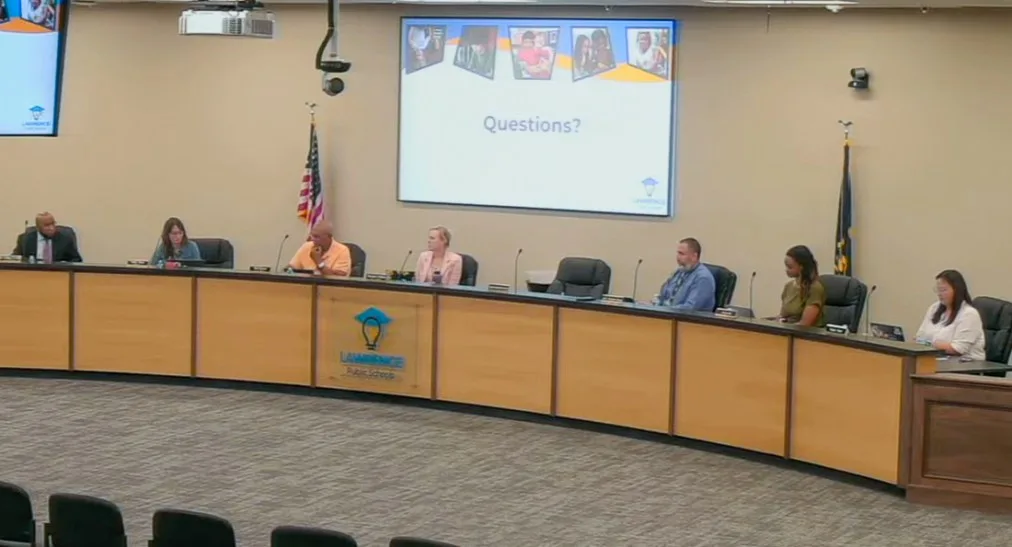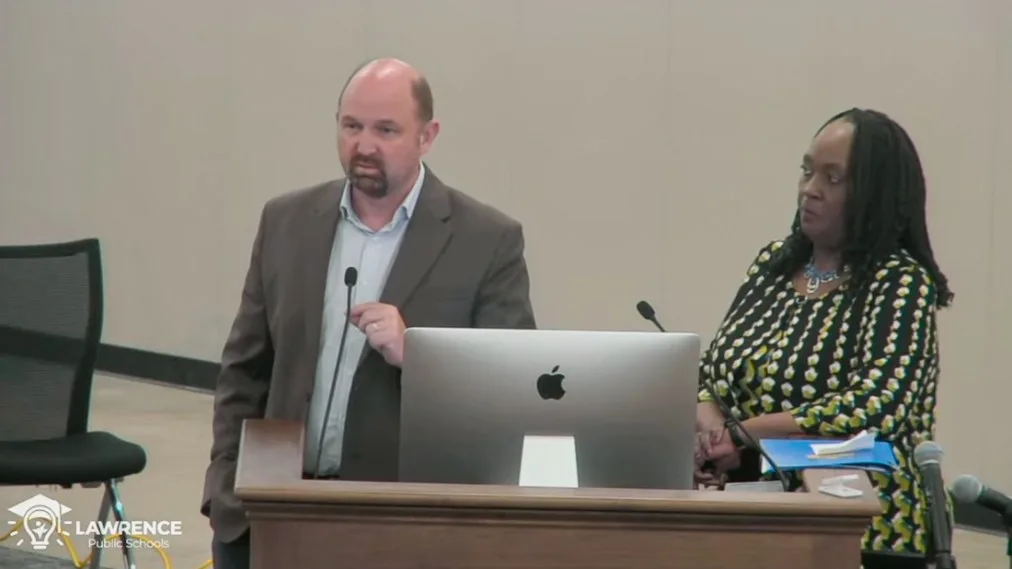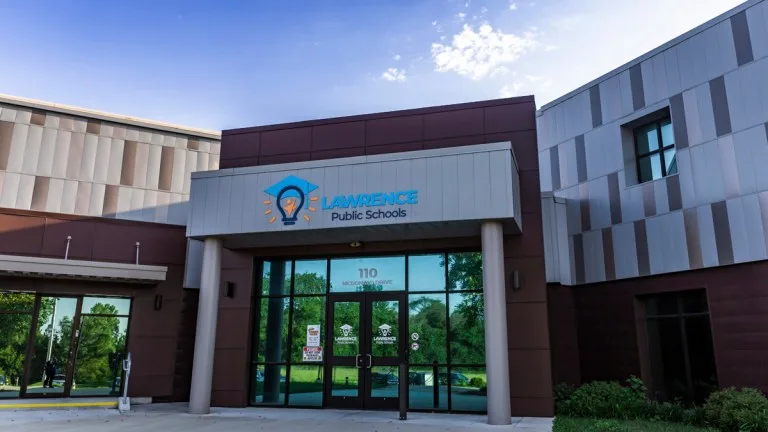The Lawrence school district is partnering with county agencies to hopefully prevent students from being introduced to the criminal legal system for missing too much school.
The district is partnering with Douglas County District Attorney Suzanne Valdez’s office, Douglas County Youth Services and the Kansas Department for Children and Families (DCF) to address truancy.
Students are considered truant if they are absent without excuse for a “significant portion” of the school day for three days in a row, for five days in a semester, or for seven days in a school year. At the high school level, a “significant portion” of the school day is one class period, according to Lawrence High School Associate Principal Mark Preut.
Kevin Harrell, executive director of student services and special education, said when students reach those thresholds, the district is mandated to report them to DCF.
Chief Academic Officer Patrick Kelly, who organized the truancy prevention program in September 2022, said the district and its partners are recentering their truancy program on prevention rather than diversion.
According to the report district staff presented to the board Monday, 29.7% of elementary, middle and high school students were chronically absent during the 2021-22 academic year. The number has increased over the past three years. High school students have the highest rates with 39% of all high schoolers and almost half (49%) of seniors being chronically absent.
Chronic absenteeism refers to students who have missed 10% or more of school days due to absences for all reasons. Kelly said the district has seen a “real dropoff in attendance, not only unexcused attendance but excused attendance” as a result of the COVID-19 pandemic.
The report shows Native American or Alaska Native and Black students were the most chronically absent racial subgroups, with 46% of Native American or Alaska Native students and 38% of Black students qualifying. White and Asian students showed the least chronic absenteeism, with 18% of Asian students and 26% of white students qualifying.

Board President Kelly Jones asked Preut how staff plan to check their biases when deciding which students to refer to the program. That way students of color or students struggling with their mental health, she suggested as examples, won’t be disproportionately targeted.
Preut said “it’s a team decision,” so no individual staff member will have room to target students. Additionally, staff will assess if progress is being made to determine if students are heading on the right track or if they may benefit from the program.
A program called SupportEd provides services for kindergarten through eighth grade students, and the O’Connell Children’s Shelter serves high schoolers. If schools send a truancy warning letter home with students, they will also send a truancy prevention program flyer.
Participation in the program is voluntary. Pam Weigand, director of Douglas County Criminal Justice Services, clarified that the truancy program is not a criminal justice matter, and a criminal record will not follow students who are involved. If students or their families refuse to participate after being referred, or if their attendance worsens while in the program, however, there will be criminal involvement.
“Really what we’re trying to do is create more opportunities for engagement prior to a formal process,” Weigand said.
Valdez said she and her office want to be of support to the district.
“We don’t want our kids to be in the criminal justice system,” Valdez said. “One thing I say over and over again until my face is blue is I’m trying to reduce the criminal justice footprint or imprint, however you want to call it. So this is all prevention. This is all intervention.”
The board had its first reading of a memorandum of understanding (MOU) draft between the district and program partners, and the board will look to approve that document at its next meeting on Monday, Sept. 11.
20230828-USD-497-MOU-DA-Signed
Lice, eye drainage not reasons to keep kids home, handout says
Cynthia Johnson, executive director of inclusion, engagement and belonging, said the district’s goal is to push last year’s 90.68% average daily attendance up to a 95% average daily attendance. Using the slogan “Every Day Matters,” the district is working to promote daily attendance across the board.

“… One of the things that I want you to remember and realize is that the goals that we have on the screen will not be a reality unless our students attend school, are actively engaged in the teaching and learning process and build those relationships and that culture of learning here in our classroom environments,” Johnson told the board during the presentation.
Monday’s presentation included a section of a handout from Attendance Works, Kaiser Permanente and the National Association of School Nurses that says children can even go to school if they “Have eye drainage without fever, eye pain or eyelid redness,” or “Have head lice,” among other symptoms. “Though they are annoying and should be treated, lice are not a reason to exclude a child from school,” the handout states.
Johnson said the district will use the handout as guidance and send information to parents and guardians to help them decide when their students should attend school in lieu of sicknesses.
“If a student has COVID, yes, we want that child to be able to stay home to heal,” Johnson said. “If that student has strep throat — these are some things that are going around within our communities — of course we want the student to stay home, once again, so that the other students in the classroom do not get infected. But most importantly, we want that child to heal and then they can return back to school.”
Attendance-Works-handout-USD-497
There was no further discussion regarding the handout Monday.
Jennifer Georgie, lead student and family support facilitator, said attendance rates are predictors of student outcomes and data shows students who are missing school are less likely to reach reading standards and may struggle more with social engagement. Teachers may need to spend more time catching up students who have been absent, which causes classroom delays, she added.
To create an action plan, the district looked to Attendance Works, a nonprofit initiative that collaborates with educational institutions to find solutions to chronic absenteeism. Potential interventions to improve attendance include calling home and developing attendance contracts with students and parents to build plans of action.
The district plans to participate in National Attendance Awareness Month on Sept. 1 as September is the first full month of school and Sept. 20 is the district’s annual “count day,” when enrollment numbers are calculated.
In other business:
• JUUL settlement: As part of Monday’s consent agenda — a list of items routinely approved in one motion — the school board approved a settlement offer as part of a class action lawsuit against JUUL investors.
The lawsuit makes the district eligible to receive $85,573, which is in addition to the $284,125 settlement offer the board approved (before attorney fees and costs) in March.
• Needs assessment: The school board on Monday also took its final review of the district’s needs assessment as part of the budget process. The assessments, required by the state, evaluate various student needs and areas for improvement at each school building.
View the 119-page needs assessment attached to the agenda item on BoardDocs.
The school board during its next meeting will look to approve the final 2023-24 budget after holding public hearings — one to potentially exceed the revenue neutral rate and the other to approve the budget itself. That meeting is scheduled for 6 p.m. Monday, Sept. 11 at district offices, 110 McDonald Drive.
If our local journalism matters to you, please help us keep doing this work.
Don’t miss a beat … Click here to sign up for our email newsletters

Maya Hodison (she/her), equity reporter, can be reached at mhodison (at) lawrencekstimes (dot) com. Read more of her work for the Times here. Check out her staff bio here.
Latest Lawrence news:

Prairie Band Potawatomi member Richard Adame urged health administrators Monday to share with tribes detailed information on attributes of natural medicines that was lost to many people through dominance of the pharmaceutical industry.
 August Rudisell/Lawrence Times
August Rudisell/Lawrence Times Hundreds of Lawrence community members showed up Sunday for the 42nd annual Kansas State Fiddling & Picking Championships, also known as FidPick.
 Molly Adams / Lawrence Times
Molly Adams / Lawrence Times The Lawrence school board on Monday will hear a report about chronic absence rates within the district and learn about proposed solutions.







